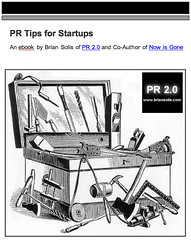Ticker PR' Closes the Gap Between IR and PR

While Investor Relations is a critical component of a company's financial trading stature, PR cannot be overlooked, as it is equally critical to influencing customer behavior. Maybe even more so, what with the fallout from the dot com era and the ensuing excitement and hype building around Internet 2.0. Perhaps that’s why IR teams have started to borrow tactics from the PR playbook as a way to increase the visibility of the stock through non-financial media channels.
This new kind of service is a way to move the stock using tools that are staples in the PR toolbox, including customer success stories, executive interviews, customer win press releases, speakers bureaus, and contributed articles.
At the same time, IR is merging with internal and external communications teams to create what I call “Ticker PR.” In its purest sense, Ticker PR is designed to increase visibility and fuel excitement for the company and its stock symbol without using traditional IR tools such as finances, stock history, sales revenue or financial analysts. But, the question is, who should own the Ticker PR initiative?
Granted, the ultimate goal is increasing the stock value, but the means to get there are rooted in traditional PR. IR's use of traditional PR tools also affects the potential effectiveness of the overall PR initiative.
For example, pitching a case study to a business or trade publication or writing and issuing a customer win press release might seem to be a given PR initiative, yet IR teams must take the lead on these projects as a way of driving the visibility of the stock in magazines and on stock tracking sites.
Isn't the lesson we learned from the dot-com Wall Street era tied directly to revenue, apabilities and real-world benefits to the customer and not hype? With all of the jockeying around Internet 2.0, we're poised to make the same mistakes again. After all, IR is qualified, staffed and capable to move stock prices, influence market makers, and appease the investor community.
But much in the same way that the PR team is not qualified to manage investor relations, IR should not attempt to extend itself into the ranks of public relations and brand management.
Yet IR's use of PR tools to promote a ticker symbol is robbing PR of its value within its own spheres of influence.
The use of milestones, customer success stories and customer win press releases are the key ingredients of a successful PR campaign. If overused or sent out to the public before the media can use it in a story, the value is greatly diminished and almost unusable by any worthy reporter. On the contrary, the investor community, whether institutional or even individual, is becoming much more savvy and skeptical of hype.
Customers have needs, pains and are constantly looking to address them. Without applying a team that understands how and where to reach those customers, the value proposition will never make its way to the decision-makers.
If potential customers are not convinced that they need to consider the value proposition, then revenue will not grow and may in fact shrink. If revenue shrinks then the company's appeal to the investment community will quickly lose its luster no matter how brilliant the IR strategy. The right IR team will take the corporate story and the market opportunity and establish working relations within the investor/financial markets. If the company is performingwell, then IR will make sure that the financial community is taking note of the growth.
The once Grand Canyonesque division between traditional PR and IR is quickly closing.
Ultimately, the fusion of IR/PR initiatives undervalues the effectiveness of PR and maybe IR overall. It is important for companies to not confuse the role of one with the other, as both provide tremendous benefits to the company and its stock. A good “total relations” team is vital to successfully create a well-rounded presence with the investment community, the media, influencers, analysts, and customers.
At the end of the day, “Ticker PR” really is just a buzzword for traditional corporate publicity, aka corporate PR. And as long as it's not hype, the company will only be better off for treating the brand as a dedicated component of the overall marketing mix.












0 Comments:
Post a Comment
<< Home